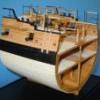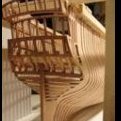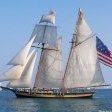Supplies of the Ship Modeler's Handbook are running out. Get your copy NOW before they are gone! Click on photo to order.
×
-
Posts
2,415 -
Joined
-
Last visited
Reputation Activity
-
 dvm27 reacted to Patrick Matthews in Lower cost (?) shiny metal parts
dvm27 reacted to Patrick Matthews in Lower cost (?) shiny metal parts
First, kudos to those who can use handwork to create beautiful shiny metal parts from real metals. Me- I'm lazy, and will go to 3D Printing every time!
I have previously shown that 3D Printing can be used to create waxes for lost wax casting of real metal parts in a variety of alloys. As one might expect, it's not a low cost approach, especially for larger parts.
But a modeller in the UK shared some results that offer another approach. He's working on a large scale Admiral's Barge, which features a polished brass stack and cowl vents. I designed the parts for him, and he procured them in the lowest price 3D Printed plastic, sintered nylon (grainy porous stuff, "fine detail plastic" would cost twice but be much easier to work with). Anyway, he filled the grain, polished that, then applied silver-bearing conductive paint. Next, brush plating of copper (which can be further buffed), followed in this case with brass plating. One can also brush plate nickel for the look of stainless or a fair-enough chrome, or invest in rhodium plating for a more convincing chrome.
Pictures show the raw plastic parts and the final product.
-
 dvm27 got a reaction from mtaylor in Frigate AURORE 1697 by s.v.atanasov
dvm27 got a reaction from mtaylor in Frigate AURORE 1697 by s.v.atanasov
Lovely work. Is that the Dr. Mike method of hull construction? It certainly is very different than some plank on frame models done here but gives excellent results.
-
 dvm27 got a reaction from Jeronimo in L'Artesien by Borek - 1:48 - based on Ancre plans
dvm27 got a reaction from Jeronimo in L'Artesien by Borek - 1:48 - based on Ancre plans
Very nice to have new members building French models, especially of this quality. wonderful work!
-
 dvm27 reacted to MEDDO in Queen Anne Barge by MEDDO - FINISHED - Syren - scale 1:24
dvm27 reacted to MEDDO in Queen Anne Barge by MEDDO - FINISHED - Syren - scale 1:24
Thanks Chuck. It was interesting using the powders for the first time and they did seem to work out pretty well.
Thank you Dave.
I like it. The pictures really show the dust but here is the attached transom area
-
 dvm27 reacted to KeithAug in Germania Nova 1911 by KeithAug - FINISHED - Scale 1:36 - replica of schooner Germania 1908
dvm27 reacted to KeithAug in Germania Nova 1911 by KeithAug - FINISHED - Scale 1:36 - replica of schooner Germania 1908
The next job was the wheel pedestal, Although it looks quite chunky in the photograph at model scale it is relatively small.
The sketch was fairly easy as I had the basic dimensions from the plan and lots of detail from photos.
The body is 0.5" square and the height is 1.53"
I cut a core from oak and then clad it to crate the panels and decorative details.
Around the top are decorative slats which I cut .020" wide on the table saw.
A hole was drilled to take the wheel spindle and the wheel was temporarily mounted.
Instruments are mounted on the top fo the pedestal. Earlier photographs of Germania feature less instruments. I based the instruments on later photos. The surrounds are cut from square aluminium tube, the faces are black card filled over with 2 part epoxy to simulate the screen.
The pedestal hasn't been varnished as yet.
-
 dvm27 reacted to KeithAug in Germania Nova 1911 by KeithAug - FINISHED - Scale 1:36 - replica of schooner Germania 1908
dvm27 reacted to KeithAug in Germania Nova 1911 by KeithAug - FINISHED - Scale 1:36 - replica of schooner Germania 1908
Thank you Steve, Chris and Michael, and thanks to everyone who has liked my build.
I went on to finish the wheel.
The brass faces and spindle for the hub were turned.
I then turned a piece of mahogany and drilled the 10 radial holes to take the spokes. The drill is .080" diameter.
It is quite difficult to tell that the grain on the rim does not follow the circumference.
The hub was parted off and the spigot mounted.
I made former from a brass tube to allow me to make the spindles.
The spindles were installed and glued.
I finished the wheel with a coat of poly. I then used the wrong end of a .020" drill to mark the positions of the rim screws. The wrong end was ground at an angle and the wheel was mounted on the mill rotary table to make the marks.
-
 dvm27 reacted to s.v.atanasov in Frigate AURORE 1697 by s.v.atanasov
dvm27 reacted to s.v.atanasov in Frigate AURORE 1697 by s.v.atanasov
My new passion. The wood that i use are oak, moraine oak, ebony, padоk. 1: 36
-
 dvm27 got a reaction from michael mott in HMS Bellona 1760 by SJSoane - Scale 1:64 - English 74-gun - as designed
dvm27 got a reaction from michael mott in HMS Bellona 1760 by SJSoane - Scale 1:64 - English 74-gun - as designed
The last photos I have of Longridge's Victory in the Science Museum showed significant separation of the planks in several areas, Mark. Maybe your properly planked hull with with non-stressed planks will fare better in 80 years.
-
 dvm27 reacted to druxey in HMS Bellona 1760 by SJSoane - Scale 1:64 - English 74-gun - as designed
dvm27 reacted to druxey in HMS Bellona 1760 by SJSoane - Scale 1:64 - English 74-gun - as designed
Remember the trick of making a maquette in modeling clay first before carving. It really helps to sort out any problems in 3D ahead of committing to wood.
-
 dvm27 reacted to Rustyj in HMS Winchelsea 1764 by Rustyj - FINISHED - 1:48
dvm27 reacted to Rustyj in HMS Winchelsea 1764 by Rustyj - FINISHED - 1:48
I've added the Syren laser cut fluted columns to the qgalleries and sanded the slope for the roof.
I've also made a test run of the shingles for the roof sticking them in place with rubber cement.
I just wanted to familiarize myself with the placement prior to gluing them in place.
This size roofing shingles are much easier on the body though I'm having a hard time finding a nail gun in this scale!
-
 dvm27 got a reaction from mtaylor in To add sails or not? What is your preference?
dvm27 got a reaction from mtaylor in To add sails or not? What is your preference?
Unless you are building an Admiralty style model! But personally, I find that very few kit sails look realistic. They are usually over scale and don't hang realistically. I think properly furled sails can greatly enhance a model but these are also difficult to make in a realistic fashion. Obviously, Rob's example above is an excellent representation of what they should look like.
-
 dvm27 got a reaction from mtaylor in Prisoner of War, Bone Ship Models
dvm27 got a reaction from mtaylor in Prisoner of War, Bone Ship Models
French prisoner of war models are still on the market for the well healed amongst us. For example, recently sold for 48,000 pounds:
https://www.charlesmillerltd.com/auction/lot/261-a-large-finely-carved-and-well-presented-early-19th-century-napoleonic-french-prisoner-of-war-bone-ship-model-for-a-first-rate-ship-of-the-line-traditionally-identified-as-hms-caledonia/?lot=12815&au=46&sd=1#
A more modest 4000-6000 pound bid might get you this smaller model:
https://www.charlesmillerltd.com/auction/lot/73-a-napoleonic-french-prisoner-of-war-bone-model-for-the-74-gun-frigate-illustrious-circa-1810/?lot=13707&so=0&st=&sto=0&au=51&ef=&et=&ic=False&sd=0&pp=48&pn=2&g=1#
-
 dvm27 reacted to archjofo in La Créole 1827 by archjofo - Scale 1/48 - French corvette
dvm27 reacted to archjofo in La Créole 1827 by archjofo - Scale 1/48 - French corvette
Hello,
in the meantime I also fixed the guiding blocks for the bunt lines at the bottom of the maintop.
-
 dvm27 reacted to SJSoane in HMS Bellona 1760 by SJSoane - Scale 1:64 - English 74-gun - as designed
dvm27 reacted to SJSoane in HMS Bellona 1760 by SJSoane - Scale 1:64 - English 74-gun - as designed
Some other life activities got in the way of the model for a while. I am grabbing a few moments in the shop from time to time, and here is an update.
Planking continues, and I am refining how to do this as efficiently as possible both for time and for materials consumed. I started ripping planks off a blank wide enough for later spiling of the individual planks. But this turned out to waste a lot of wood that was initially cut too wide for the final plank. So I then made manila file templates for each plank in the second strake of the channel wales:
Then I laid these out on the blank port and starboard of each piece next to each other to avoid different curves wasting more wood (I will flip the starboard ones when fitting):
These are now cut out on a scroll saw, and ready for sanding to size and fitting:
Meanwhile, I have been thinking about the carvings on the head and stern, since I took the time to draw them out earlier. They are going to be small, particularly on the stern, as seen by the mechanical pencil on the drawings:
Will I be able to make them look anything like the original? Daunting!
All for now,
Mark
-
 dvm27 got a reaction from shipman in Cutter Alert 1777 by Dali - FINISHED - scale 1:48
dvm27 got a reaction from shipman in Cutter Alert 1777 by Dali - FINISHED - scale 1:48
Thank you for sharing your work with us, Dali. Your craftsmanship is wonderful!
-
 dvm27 reacted to druxey in Mary Day by jdbondy - 1:64 scale (3/16" to 1 foot) - Schooner
dvm27 reacted to druxey in Mary Day by jdbondy - 1:64 scale (3/16" to 1 foot) - Schooner
Impressive progress - particularly at this small scale! I wonder if using a binocular microscope constitutes cheating? Next you'll be using a microtome to produce frames....
-
 dvm27 reacted to jdbondy in Mary Day by jdbondy - 1:64 scale (3/16" to 1 foot) - Schooner
dvm27 reacted to jdbondy in Mary Day by jdbondy - 1:64 scale (3/16" to 1 foot) - Schooner
In my last two posts, I included an image that represented a significant jump ahead in the work on the model. Now I will fill in some of the blanks on how I came to the point of having so many frames filled in on the model’s baseboard.
I could theoretically have omitted the rabbet from this model, and created a garboard plank with an edge that just abuts the keel. But given the Christmas craft project I completed and showed in the last post, I certainly now feel comfortable with the idea of carving out a small rabbet into the edge of the keel. I think it also will make the installation of the planking easier, and also some degree of rabbet carving would be absolutely necessary in the area of the deadwood.
In the month of February I got to visit the Rockland Apprenticeshop on the coast of Maine. There I watched an apprentice working on carving out the rabbet on a full size keel for a lobster boat they are constructing. At full scale, of course, when carving out a rabbet, you have the benefit of fully lofted rabbet lines, bearding lines, and apex lines. At my scale, though, all that is going to have to be eyeballed.
So, I took a deep breath, and while holding a frame for a particular station against the keel using a jig, I laid out and started to cut small areas of the rabbet at a couple of different stations. I used a 3/64” thickness strip of wood as a simulated plank in order to check the depth of the rabbet and the interface between the edge of the plank and keel to make sure I wouldn’t have a gap. I now regret not having a picture of my jig for holding everything while I worked on it.
In this picture I have carved out 3 different locations, which enabled me to carefully extend the rabbet between these locations.
The process involved a lot of moving back and forth between the jig and the microscope, through which I monitored my carving. I did use some of the same micro-chisels that I constructed for the Christmas craft project I had just completed.
Here I am starting to extend the rabbet into the stem.
A long, straight segment of the rabbet in the midships area has been finished here. I stopped at this point and awaited further development of the stem and stern framing before working on the stem rabbet and the deadwood (which hasn’t been constructed yet).
Next step was to solidify the job of the baseboard by installing guides for the placement of the station frames. I used basswood of approximately 3/16” thickness to create shapes that resembled the shape of the frames they would support, but smaller in size so as not to interfere with the future process of fairing the shape of the hull once all frames were in place.
As these were put in place, they were of course checked against the keel to make sure that the frame remained vertical and articulated with the keel in the correct location. I believe this is station 6 (of ten).
Station 7’s support pieces were installed in the same way. Then, between stations 6 and 7, the intervening frames were test fitted, with additional pieces of basswood of appropriate thickness to support each of them. In this photo, the sheets of paper are being used to leave some residual space adjacent to each frame, to reduce friction.
The sheets of paper have been removed.
A detail of the edges of the frames as they sit on the boards. Shims are being installed to ensure accurate location of the frames at the level of their bulwark stanchions. Some of the frames in the image are still unsupported. Others have their fore and aft shims installed, while the frames on the station lines have fore and aft shims as well as shims to restrain their transverse movement.
Once I was happy with the frames’ positioning on the baseboard, the keel was brought in, and the filler blocks located between the foot of each frame were installed. Compared to the waterline, there is an upslope of 2 degrees as the keel moves toward the bow. So this angle had to be accounted for in order to make sure that the slots for the frames were oriented vertically. The miter gauge with the Byrnes table saw made this easy work.
Just making sure that everything here is still staying vertical…this was a good way to make sure that the keel pieces between the frames were of the right length and that errors weren’t creeping in.
Then it’s on to the next station and its support pieces. In the end, I think only the station frames will have these support pieces permanently installed.
Here I am using the frames to draw out the shapes for the basswood support pieces that are put between the frames.
Shims have been installed between these stations.
Building up the sandwich that is going to make up the shape of the hull. At this point, I am opting to use boxwood for the frames in the midships and in the bow, and trying to confine the use of plywood to the aft part of the hull. That way, if I want to leave a part unplanked for display, the forward half of the ship will look authentic. If I opt to do that, the exposed frames will have to be trimmed to their actual molded dimensions rather than being solid bulkhead-type pieces of wood.
More of the keel spacer pieces have been installed.
Next up will be the deadwood, which will cause all sorts of questions to arise!
-
 dvm27 reacted to giampieroricci in LA VENUS 1782 by giampieroricci - FINISHED - Scale 1:96 - French Frigate
dvm27 reacted to giampieroricci in LA VENUS 1782 by giampieroricci - FINISHED - Scale 1:96 - French Frigate
The bow light:
-
 dvm27 got a reaction from bruce d in Cutter Alert 1777 by Dali - FINISHED - scale 1:48
dvm27 got a reaction from bruce d in Cutter Alert 1777 by Dali - FINISHED - scale 1:48
Thank you for sharing your work with us, Dali. Your craftsmanship is wonderful!
-
 dvm27 reacted to Dali in Cutter Alert 1777 by Dali - FINISHED - scale 1:48
dvm27 reacted to Dali in Cutter Alert 1777 by Dali - FINISHED - scale 1:48
This is what Alert looks like today.
Greetings, Piotrek
-
 dvm27 reacted to Tompslattery in Germania Nova 1911 by KeithAug - FINISHED - Scale 1:36 - replica of schooner Germania 1908
dvm27 reacted to Tompslattery in Germania Nova 1911 by KeithAug - FINISHED - Scale 1:36 - replica of schooner Germania 1908
Hi Keith this looks amazing
I was wondering what is it you’ve placed under the skylight grills, the blackish bit? You may have already mentioned and I might have missed it.
thanks
Tom
-
 dvm27 reacted to giampieroricci in LA VENUS 1782 by giampieroricci - FINISHED - Scale 1:96 - French Frigate
dvm27 reacted to giampieroricci in LA VENUS 1782 by giampieroricci - FINISHED - Scale 1:96 - French Frigate
a few steps forward:
-
 dvm27 got a reaction from MEDDO in To add sails or not? What is your preference?
dvm27 got a reaction from MEDDO in To add sails or not? What is your preference?
Unless you are building an Admiralty style model! But personally, I find that very few kit sails look realistic. They are usually over scale and don't hang realistically. I think properly furled sails can greatly enhance a model but these are also difficult to make in a realistic fashion. Obviously, Rob's example above is an excellent representation of what they should look like.
-
 dvm27 reacted to michael mott in Macton locomotive works III by michael mott - 27/32 scale - METAL
dvm27 reacted to michael mott in Macton locomotive works III by michael mott - 27/32 scale - METAL
quite right Druxey there certainly will be gaps for the flanges This picture shows it a little more clearly, I have been shaping the rails and there will be enough clearance in both rail sizes for the wheels of each to clear.
This overhead shot gives a better view of the way the track will set.
The points will function as a normal set will function. The most fiddly part will be filing the gaps in the large and small rails at the cross over place. One of the comments in the Crewe book is that most of the points on the narrow gauge were kicked over by the driver when needing to change tracks.
Mark and Egilman welcome to this new project.
Michael
-
 dvm27 reacted to druxey in Model Ship's Carvings
dvm27 reacted to druxey in Model Ship's Carvings
Directional light, whether natural (sun) or artificial (candle, oil lamp) would have been best. I suspect that many of the old-time carvers were either short-sighted to be able to work close, or wore spectacles. The Art Gallery of Ontario in Toronto has the 'kit' of a 17th century miniature carver along with his spectacles and examples of his amazing miniature work.
See:
https://boxwood.ago.ca/publication/making-gothic-boxwood-miniatures
and
https://www.metmuseum.org/art/collection/search/705181








